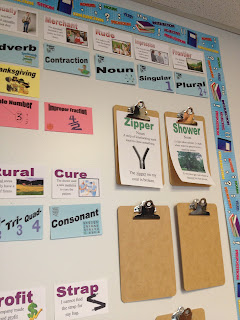I've had the opportunity to have conversations with many of our ELL departments and a common theme in each of them is, how can we do a better job of addressing basic langauge acquisition while supporting classroom learning?
It's a hard thing to balance, and often the feeling is that we have to do more content support than direct language instruction. This can feel frustrating and worse, like you're really missing the point of being a teacher of English Language Learners.
Happily, many of our colleagues are finding creative ways to balance those two important areas. Instead of just displaying a word wall, they've made it a living, functioning place where students are expected to actively engage with and learn from it. What I love most about these examples is how organized and deliberate they are, and of course the illustrations!
How can we advocate to our classroom teachers the importance of living word walls like these? I believe a good place to start is to take examples from the schools below. Set up a wall in your room/area/cart(!) as a model for other teachers to get inspiration from. Do you have a crafty student? Have them be your illustrator.
 |
| *Hamtramck Charter, MI |
 |
| Ridge Park, MI |

No comments:
Post a Comment